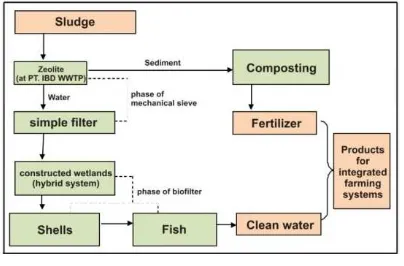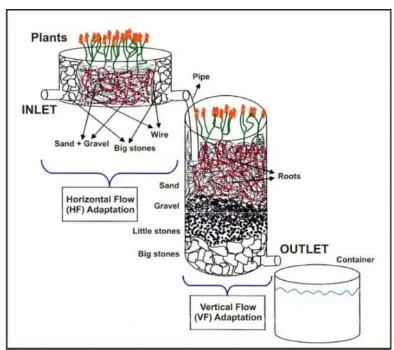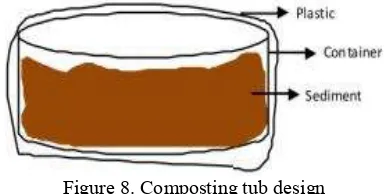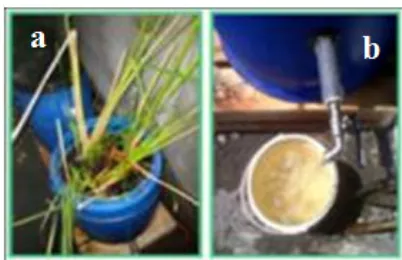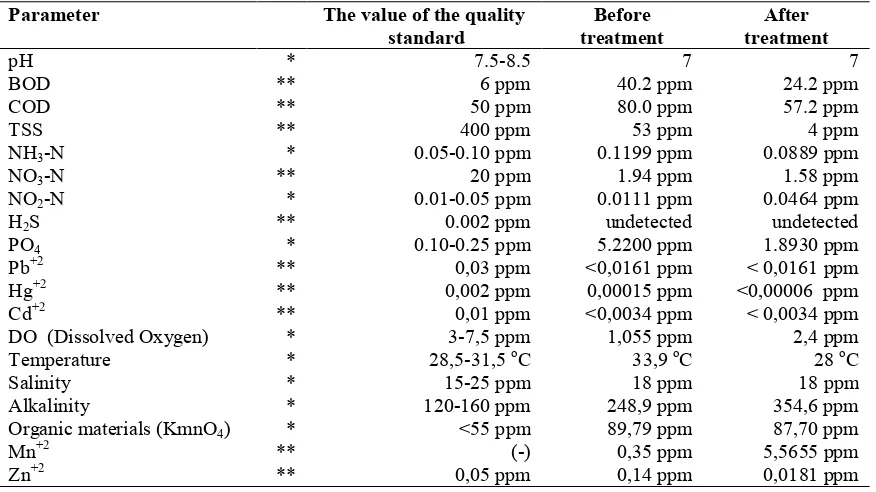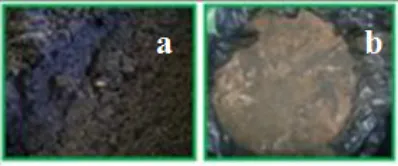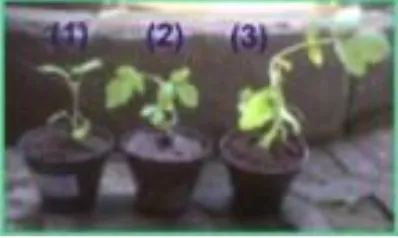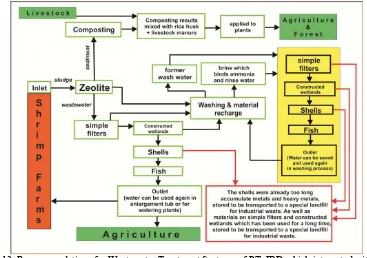ISSN: 2339-076X, Volume 3, Number 1 (October 2015): 423 - 432
DOI:10.15243/jdmlm.2015.031.423
Research Article
Waste management of shrimp farms as starting point to develop
integrated farming systems (case study: Kuwaru Coast, Bantul,
Yogyakarta, Indonesia)
H.G. Saiya*, D.R. Katoppo
Magister of Environmental Management, UGM, Yogyakarta, Participant at Trial Study Programme at PT. IBD * corresponding author: halvina.grasela@mail.ugm.ac.id
Abstract:
Intensive waste management is a solution to maintain an area of ecological harmony but still can produce economic benefits that are beneficial to social welfare. So in this research, waste of shrimp farms which was just processed by using zeolite, was treated again with a few treatments, i.e. simple filters, constructed wetlands, shell, fish and composting. Simple filters were composed of stone, gravel, coral, charcoal, sand and coconut fibers. Constructed wetland system used was hybrid type which combines type of horizontal flow and type of vertical flow. The shell used wasPolymesoda erosa. The fish used was Tilapia. In the composting sediment activator,biang komposwas used with the composting time of one month. The results indicated that the system of simple filters, constructed wetlands, shells and fish proved to be quite effective to reduce levels of pollutants in wastewater and will be more effective if treatment was accompanied with a proper aeration. While, the sediment composted into fertilizer needed to be composted with a longer time than normal composting time. This was because the composted materials were derived from waste having a very low nutrient, so it took longer to restore nutrients. The results also indicated the potential of shrimp farm waste of PT. IBD to be processed into clean water and fertilizer. With the appropriate policies and strategies, this can lead to the development of an integrated farming system to support sustainable coastal ecologically, economically and socially.Keywords:shrimp farms,integrated farming systems, waste management
Introduction
Shrimp farming is one of the fisheries sector with a sizeable economic benefits, thus becoming one of the priorities in the development of aquaculture in Indonesia. Shrimp farming activities in the process will be intersect with environment and ecosystem such as land, coastal waters, flora and fauna, as well as local community, so as to reduce the direct impact caused by shrimp farming activities it needs to be a good business management and sustainable that will produce environmentally friendly farming activities and support sustainability in various sectors of the community area. Industrial sector is growing rapidly, implications for pollutant load of industry waste products on the environment which can affect the lives of living beings. All aquaculture industry, that extensive aquaculture and intensive aquaculture must environmentally in order to
achieve industrial activities friendly to the environment.
Kuwaru Coast located in Poncosari Village, Sub-district of Srandakan, Regency of Bantul, Yogyakarta is one of the areas used by the public as shrimp farming area, and some other community members use the land for agriculture and plantations. Shrimp farms are growing in the area spearheaded by PT Indokor Bangun Desa (IBD), where most labor at PT IBD derived from the surrounding community around Kuwaru Coast.
follow the rules of good in addressing major issues related: (a) produce a lot of fish without increasing the use of natural resources (soil and water) significantly; (b) build a sustainable farming system without harming the environment; (c) building a culture system with a ratio of cost/benefit rationally in order to support the continuation of farming economically and socially. So that, management in an integrated farming system is required for the sake of sustainability as part of management efforts which not only benefit employers, but also has the advantage alignment for the economy of local communities, states, and especially the regional environment where life place for humans, animals, and plants at Kuwaru coastal area (Abiotic-biotic-social).
The development of shrimp farming are rapidly, extensively or intensively produce a variety of effects and environmental issues. Nur (2011) stated that aquaculture waste products can be: (a) solids, especially in the form of residual feed, fish feces, and bacterial coloni; (b) solute, such as ammonia, urea, carbon dioxide, phosphorus and hydrogen sulfide. This waste will increase with lower feed conversion. In this condition is necessary to adjust the amount of feed to prevent the buildup of residual feed which can increase pollution on cultivation medium, expanse around maintenance media, and coastal zone. Each cultivation, before disposing of aquaculture residual water into waters should meet the quality standard of effluent (wastewater) pond which has been established in accordance Peraturan Pemerintah (government regulation) Number 82 In 2001 About Management of Water Quality and Water Pollution Control and Kepmen (Marine and Fisheries Minister’s Decision of Indonesia Republic) number 28 in 2004 about Guidelines on Shrimp Farming in Ponds.
Utilization water treatment ponds to accommodate and treat wastewater product from the farm is a way of the wastewater management before being discharged into the sea so it does not pollute the environment. Wastewater Treatment Plant (WWTP) is a wastewater treatment site that treat wastewater until meets the quality standards (Peraturan Daerah/Local Regulation of Bantul Regency number 15 in 2010 about wastewater management), or in other words WWTP is a technique that has a complete range of processing equipment to process the liquid remaining from the production process so it can be suitable for discharge to the environment.
Based on Law (Undang-Undang) number 32 in 2009 about The Environment Protection and Management, article 1 state that waste is residue of a business and/or activities, while the liquid
waste according to the Decree of the Environment Minister number 51 in 1995 is waste in liquid form generated by industrial activity released into the environment and could be expected to lower the quality of the environment. Whereas, environmental pollution according on UU number 32 in 2009 is entry or the inclusion of living things, matter, energy, and/or other components into the environment by human activities that exceeds the environmental quality standards established. So as to reduce levels of pollutants which may affect the environment ecosystem required a planning effort in order meet with farm activities regulations and to maintain the environment remain stable with integrated farming system.
Integrated farming system is system that combines aquaculture activities, agriculture, farming, forestry, animal husbandry, community as well as the traditional market, and the pattern of other communities which have relevance in the cycle of these activities. Integrated farming system is expected to increase development of rural communities in an integrated productivity, community development programs independently, and environmental conservation. In principle, integrated farming system is a system utilizes all the potential energy so it can be used in balance. So this is also related to utilization of aquaculture waste products which can maintain the stability of the ecosystem. According to Peraturan Daerah (Local Regulation) of Bantul Regency number 15 in 2010 about Wastewater Management, Kepmen (Marine and Fisheries Minister’s Decision of Indonesia Republic) number 28 in 2004 about Guidelines on Shrimp Farming in Ponds, Decree of the Environment Minister number 51 in 1995 about Liquid Waste Quality Standard for Industrial Activities, Permentan RI (Agriculture Minister Rules of Indonesia Republic) number 70 in 2011 about Organic Fertilizers, Biological Fertilizers and Soil Moisturizer, and UU (Undang-Undang) number 32 in 2009 about The Environment Protection and Management, utilizations of waste products, both water and sediment include the reused water by advance processing so it is worth to be recovered, and while the reutilized of sediment as organic fertilizer with the processing of a aquaculture waste treatment.
Based on the above, then there are two problems, (1) how to create an integrated farming utilizing aquaculture waste products and strive for environmentally friendly economy?; (2) how are policies and integrated strategies for sustainable coastal ecologically, economically and socially?
waste that can be formulated as the starting point to launch an integrated farming system. Based on that, then a important part which must be tested in order to develop integrated farming system was treatment to aquaculture waste products that were in the forms of wastewater and sediment. If water and sediment from aquaculture waste products can be processed properly, this will increase their chances to be used again, that create a sustainable cycle. Therefore, experiments about the treatment to be given to aquaculture waste products need to be made so it can be used again. Referring to the problem to be solved, the intended uses are fertilizer and clean water for watering plants or if possible, water from waste products can be used again in the enlargement tub.
Materials and Methods
Tools and materials used in this research were dredge tool (hoes, shovels and buckets), drums and pan, stone (large size), stone (small size), charcoal, coral, gravel, fibers from coconut fibers, sand, pipe or rubber tube, Typha angustifolia, Cyperus papyrus, wire, rope, wood, Shell, Fish, sieve, sack, weigher, livestock manure, analytical balance, thermometer, DO meter, litmus paper and pH indicator, refractometers, biang kompos (activators), sample bottles and aquaculture waste products (Figure 1).
Figure 1. Trial Plan
Required products for initiating an integrated farming system are fertilizer and clean water from the aquaculture waste products processing. For that, experiments were focused on the aquaculture waste products processing to produce fertilizer and clean water. Based on the modification of the data from Tancung and Kordi (2010); Widiyanto (2010); Maulina et al. (2012); Rossiana and Priajati (2014), the process of aquaculture waste products was divided into two phases, in which the first phase use a mechanical sieve and the second phase was the use of biofilters.
Mechanical filter stage was divided into two stages, i.e. zeolite stage (through a procedure that was done in PT.IBD WWTP) and simple filter stage containing stone, coral, gravel, charcoal, sand and fibers. Biofilter stage was divided into three stages, i.e. constructed wetlands stage containing water plants; shell and fish. At first, aquaculture waste products which were the mixture of wastewater and sediment, were treated using zeolite through a procedure that was done in PT. IBD WWTP (Figure 2).
Figure 2. Zeolit tub at PT. IBD WWTP
Separate wastewater and sediment were obtained from this phase. Next, wastewater was proceeded to a simple filter system where the wastewater passed several layers of filter containing stone, gravel, coral, charcoal, sand, and fibers (Figure 3).
Figure 3. Simple Filter Design
weeks in vertical flow adaptation). For the last stage, wastewater was continually treated with shell and fish. Laboratory tests showed whether the quality of the trated waste was in accordance with the quality standards or not.
Figure 4.Drums that have been compiled for the filter
Simple filter method that was aimed to purify water with a layer consisting of stone, coral, gravel, charcoal, sand, and fibers is one method of water purification suggested by Suripin (2002) as a simple method of water purification using simple technology as well as readily available materials and tools. Fiber is used because it has flexibility and density so making it easy to filter out large dirt in water. Charcoal is very effective in removing odors and flavors existing in water. Charcoal used may be wood charcoal or charcoal from coconut shell. Charcoal is used to filter/eliminate odor, color, contaminants in water; as protector and exchange resin in water filtration materials. Stones, coral and gravel serve to filter out large-size materials and absorb more ions from pollutant which may still pass the screening with zeolite. Whereas, sand is very effective as filter media in order to get clean water.
Constructed wetlands are artificial wetlands that are managed and controlled by humans for the purposes of wastewater filtration with the use of plant, microbial activity, and other natural processes (Hesket and Bartholomew, 2001). Constructed wetland is natural wastewater treatment consisting of three main factors, namely: (1) flooded area and supports life aquatic plant types of hidrophytes; (2) growing medium
such as soil that is always filled with water; and (3) water-saturated media (Crites and Tchobanoglaus, 1998). The wastewater treatment system was preferred for several reasons as follows: (1) it can treat domestic waste, agriculture and some industrial waste, including heavy metals; (2) it has high efficiency in processing (80 %); and (3) its cost of planning, operation and maintenance is cheap and it does not require high skills (Tangahu and Warmadewanthi, 2001). Based on the technical approach and cost-effectiveness, the systems were chosen for the following reasons: (1) construction is cheaper than the other alternative waste treatment systems; (2) operational and maintenance costs are cheap and time operations periodically are not continuous; (3) it has high tolerance to fluctuations in wastewater discharge; (4) it is able to treat wastewater with a variety of types and concentrations of pollutants; and (5) it allows for the implementation of reuse and recycling (Haberl and Langergraber, 2002).
For wastewater from PT. IBD shrimp farms then the system of wetlands that can be suggested was wetland system with a hybrid system (Figure 5).
Figure 5. Constructed Wetlands design
Wastewater released from horizontal type was also left for 2 weeks in a vertical flow type which used large drum containing stone, gravel, sand andT. angustifolia.
Shells are aquatic animals that can absorb heavy metals, so by using the shells, then ions of heavy metals or other pollutants can be absorbed (Tancung and Kordi, 2010). The shells used in this study was Polymesoda erosa or Kerang Kepah (Figure 6). This species is often found living in tidal mangrove areas.P. erosahas been able to live in brackish water conditions, so it can also adapt to the wastewater conditions of PT.IBD that is brackish.
Figure 6.The position of shells hanged to be put in the drum containing wastewater that had been through treatment process until the constructed wetlands stage.
After 3 days of treatment with shells, then the shells removed from the drum and then replaced with fish and left for 3 days. The fish used for this study was Tilapia (Figure 7).
Figure 7.Tilapia was put into the drum containing wastewater that had been through treatment process until shells.
The quality of water produced was referred to Kepmen (Marine and Fisheries Minister’s Decision of Indonesia Republic) number 28 in
2004 about Guidelines on Shrimp Farming in Ponds, about water quality parameters in enlargement tub and Peraturan Pemerintah (Government Regulation) number 82 in 2001 about management of water quality and water pollution control with reference to Class III water quality criteria (class of water for freshwater fish farming, livestock, water to irrigate crops and other uses that require the same water quality).
Working procedures for the handling of sediment into fertilizer, were adapted from the manufacture of organic fertilizers of solid waste paper industry (Komarayati and Pasaribu, 2005) and modified by making fertilizer using biang kompos. The working procedures were as follows: (1) sediment samples that will be used were taken partly for laboratory analysis; (2) sediment was washed to remove dirt, then dried, then weighed or measured the thickness of the material to be composted.
Comparison betweenbiang kompos and the materials used for eachbiang komposwas 500 g, that could be used as much as possible for the material to be composted with a thickness of 75 cm; (3) biang kompos was mixed with a little water then sediment that has been placed in the pan flushing with that, while still stirring until becoming homogeneous material. If the mixture was not homogeneous add a little water; (4) then covered with a black plastic sheet to keep the humidity for one month; (5) stirring was done every single week and pH measurement; (6) after 30 days then the samples were taken to be analyzed in the laboratory; (7) next, sediments that had been through the composting process was given a mixture of livestock manure and rice husk; (8) application to plants.
Figure 8. Composting tub design
Results and Discussion
Current conditions at PT. IBD Wastewater Treatment Plant (WWTP)
PT. IBD has a WWTP which is located at the east end of the PT. IBD site, which consists of tanks filled with zeolite. PT. IBD treats sludge from shrimp ponds before being discharged into the sea simply by using a zeolite, while the sediment that settles at the bottom of the WWTP tub is dredged and stacked around the WWTP area. This shows that the operation units in wastewater treatment used by PT. IBD are operating units that are adsorption, namely the operation of water treatment units with the ion exchange principle, that is soluble material bonded to a substance (Suprihatin and Suparno, 2013), in this case, PT. IBD uses zeolite.
After several times of adsorbing the contaminant ions, the zeolite will enter the saturation phase. Saturation phase is adsorption process that has ended because there has been a balance between the adsorbed material and the remaining material in the water (Suprihatin and Suparno, 2013), this means that the zeolite that has been used several times is no longer able to absorb pollutants, so that in this condition the zeolite must be regenerated or replaced with the new one. It should be time consuming to replace the zeolite after its use in a certain period. It must be examined again by using the principles of adsorption unit dimensions (contact time, altitude and speed of filtration). Another alternative is to observe results of laboratory tests of water quality at the inlet and outlet of WWTP.
Another way to do is to recharge the zeolite, by way of zeolite soaked with brine (ratio of salt to water is 100 g of salt per 4 L of water). Soaking can be done during overnight, then in this way the zeolite will release ammonia into a brine. After that, zeolite is rinsed with clean water and ready to be used again (Twigg, 2008).
Results of wastewater treatment
Wastewater that was taken from WWTP outlet, was screened by using a simple filter which have been prepared in accordance with the design and filtration, was repeated twice (Figure 9). Observation of wastewater filtered with a simple filter was the smell of ammonia that was reduced drastically, and the color of the water tended to be clear.
Wastewater treatment was followed by contructed wetlands with horizontal flow type (Figure 10) and vertical flow type, that is hybrid type. The visible result was the unchanged water color, but there was a little smelly soil and plants
because of long submerging with water. However, there was no odor of ammonia. Another result indicated that, C. papyrus was found dead and could not survive in condition of substrate submerged in water for a long time, while T. angustifolia well tolerated in this condition, it looked at the yellowing leaves but the plant was still producing new tillers. This shows that T. angustifolia has better endurance on the waterlogged substrate than C. papyrus. T. angustifolia in aqueous media needs to be preserved by binding the leaves to remain upright and not broken, as well as the leaves tend to turn yellow and dry completely should immediately cut. So for this condition, highly recommended is only usingT. angustifolia.
Figure 9. Wastewater collected from the WWTP outlet (a), wastewater condition after passing through the filter at the first drum (b), and the second drum (c)
Figure 10. Condition of constructed wetlands with horizontal flow type after a few days (a), and wastewater condition after treatment with hybrid type of constructed wetlands (b).
Table 1. Results of laboratory tests on wastewater samples
Parameter The value of the quality standard
Before treatment
After treatment
pH * 7.5-8.5 7 7
BOD ** 6 ppm 40.2 ppm 24.2 ppm
COD ** 50 ppm 80.0 ppm 57.2 ppm
TSS ** 400 ppm 53 ppm 4 ppm
NH3-N * 0.05-0.10 ppm 0.1199 ppm 0.0889 ppm
NO3-N ** 20 ppm 1.94 ppm 1.58 ppm
NO2-N * 0.01-0.05 ppm 0.0111 ppm 0.0464 ppm
H2S ** 0.002 ppm undetected undetected
PO4 * 0.10-0.25 ppm 5.2200 ppm 1.8930 ppm
Pb+2 ** 0,03 ppm <0,0161 ppm < 0,0161 ppm
Hg+2 ** 0,002 ppm 0,00015 ppm <0,00006 ppm
Cd+2 ** 0,01 ppm <0,0034 ppm < 0,0034 ppm
DO (Dissolved Oxygen) * 3-7,5 ppm 1,055 ppm 2,4 ppm
Temperature * 28,5-31,5oC 33,9oC 28oC
Salinity * 15-25 ppm 18 ppm 18 ppm
Alkalinity * 120-160 ppm 248,9 ppm 354,6 ppm
Organic materials (KmnO4) * <55 ppm 89,79 ppm 87,70 ppm
Mn+2 ** (-) 0,35 ppm 5,5655 ppm
Zn+2 ** 0,05 ppm 0,14 ppm 0,0181 ppm
Note: undetected means are at very low levels;*the quality standard parameter refers to the Kepmen 28/2004;**the quality standard parameter refers to the PP 82/2001; mark (-) means for the class, parameter is not required
Based on Table 1, it can be seen that the parameter concentration levels decreased (towards quality in accordance with the quality standards) or the parameters concentration levels that had passed to normalize appropriate quality standards were BOD, COD, TSS, ammonia (NH3-N), nitrate
(NO3-N), PO4, Hg+2, DO, temperature, organic
materials, Mn+2 and Zn+2. However, these parameters have not yet met the quality standards or nearly met the quality standards. Moreover, alkalinity increased, where this could be caused by CaCO3 that was still present in the coral and
gravel used. The increase of alkalinity could also be due plankton activity.
This condition can be normalized by way of: (1) adding acid to the water (for example: sodium bisulfate); (2) after acid is added, do aeration until the pH increases; (3) do step (1) and (2) repeatedly until the measured alkalinity value achieve the quality standard value. Addition of acid will lower the pH as well as lowering the alkalinity, however when the aeration is done then the pH will rise again but alkalinity will not rise (Lovibond Water Testing, 2014). Another thing, was the increase of nitrite although it did not exceed the quality standards.
The increase of nitrite may be due to an imbalance in the nitrification process, caused by a lack of dissolved oxygen/DO (Tancung and Kordi, 2010). Solutions that must be considered are performing intense and controlled aeration
wastewater treatment especially at biofilter phase (constructed wetlands, shell and fish). Based on these, then the important things that need to be added to the waste management system is aeration should be done also on the treated wastewater. Intense aeration should be done at constructed wetlands stage, shell stage and fish stage. This is because, sufficient dissolved oxygen and continuously updated per unit of time will make the condition of constructed wetlands, shell and fish are not in anaerobic conditions. Because if the system is in anaerobic conditions, the effectiveness of the system was to be reduced, so that the organic materials are supposed to be decomposed by microorganisms in the water or through oxidation reactions will not run optimally. Then, when the wastewater enters the biofilter stage, then aeration should be executed. With good aeration then, alkalinity will not increase too high, organic materials will decompose or oxidize, DO be stable so the other parameters will be normal, even nitrification in the water will run with the balance. Additionally this system should be aligned with recharge the zeolite, washing materials as well as storage and stockpiling of materials that can not be used anymore.
Results of sediment composting
remain in a neutral condition which is 7. Also, it can be seen some indications that the composting process occurs in sediments, that is: in the second week of composting are maggots in the sediment; while in the third week there is a white fungus and brownish red fungus that appears. Until the end of composting time and sediment that has been composted ready to be tested to the laboratory, the smell of the sediment still there. This is a natural thing, because sediments derived from sludge with a high content of ammonia. But when sediments are mixed with rice husk and livestock manure and applied to plants, the smell tends to decrease, even after a few weeks it will not smell of ammonia. As for the laboratory performing the test is BBTKLPP Yogyakarta and LPPT UGM. In
Table 2 it can be seen that pH of sediment before and after composting is at neutral conditions, this shows that the pH of sediment already at optimum pH range to be used as fertilizer.
Figure 11. Sediment composted in the second week (a) and in the third week (b)
Table 2. Results of laboratory tests on sediment composted
Parameter The value of
the quality standard
Before composting After composting
pH 4-9 7 7
C/N Ratio 15-25 3,95 8,17
Hg+2 Max. 1 ppm 0,05804 ppm 0,01484 ppm
Pb+2 Max. 50 ppm 12,089 ppm 7,572 ppm
Mn+2 Max. 5000 ppm 92,874 ppm 88,502 ppm
Zn+2 Max. 5000 ppm 21,689 ppm 15,865 ppm
Cd+2 Max. 2 ppm < 0,717 ppm < 0,717 ppm
Macro nutrients: N + P2O5+ K2O Min. 4 % 0,557 % 0,418 %
N 0,04 % 0,10 %
P2O5 0,291 % 0,260 %
K2O 0,226 % 0,058 %
E. coli Max. 102MPN/g negative negative
Salmonella Max. 102MPN/g negative negative
Novizan (2012) states that, in general, nutrients are easily absorbed by plant roots at neutral pH, because at neutral pH nutrient most easily soluble in water. While the C / N ratio is still low and does not meet quality standards. Winarni et al (2013) explains that the balance of C / N will determine the balance of vegetative and generative phase. High nitrogen content or the ratio C / N is small will make the plants remain in a vegetative phase. Plants that remain in the vegetative phase of course will have problems in the process of flowering and fruiting. Because the requirements of the flowering process is generative phase that has been reached. Plants with C / N ratio is high it will be easier stimulated to immediately enter the generative phase so that the process of flowering and fruiting may occur soon. However, the value of C is too high without offset by a sufficient amount of nitrogen will cause the death of plants or will not bear fruit in
the next season. Furthermore, metals and heavy metals remain in quality standards, but it must be controlled, because metal and heavy metal is accumulative. Besides, the macro nutrients to increase in nitrogen but phosphorus and potassium decreased, and if three elements are calculated, the percentage not meet quality standards, it is also related to the C / N ratio is still low. As for E. coli and Salmonella, laboratory test results showed that material reacts negatively, thus indicating non-existence of the two types of bacteria.
of tomato plants ready to be transplanted into pots. There are 3 pots are used, with each pot contain: The first pot contains sediment composted + rice husk + livestock manure with a ratio of 1:1:1; The second pot contains a mixture of fertile soil and sediments composted with a ratio of 1:1; The third pot contains fertile soil.
Figure 12. Comparison of tomato plants grown in three different media: (1) sediments composted+rice husk+livestock manure (1:1:1); (2) fertile soil+sediments composted (1:1); (3) fertile soil.
In the figure 12, it can be seen that tomato plants grown on media of composted sediment + rice husk + livestock manure have stunted growth when compared to the other two types of media. This is because nitrogen in the sediments composted not balanced with phosphorus and potassium (Table 2), thus indicated experiencing excess nitrogen. In addition C / N ratio is still low causing sediment immature for use as fertilizer. For it can be explained that: (1) the need for a longer composting time to raise the ratio of C / N; (2) the need for the addition of other organic materials to enrich the nutrient; (3) routine laboratory tests (an important parameter: C / N ratio and macro nutrients) will determine the sediment has been ready for use as fertilizers and will be optimized to work in plants.
Results of this trial showed that if sediment from shrimp farms is not composted then the sediment is not eligible to be used as fertilizer. However, sediments from PT. IBD shrimp farms still has the potential to be used as fertilizer by implementing long time composting until the C / N ratio meets quality standards and the addition of some organic materials to meet the needs of macro nutrients. Composting time should be longer and not the same as the composting time for compost constituent ingredients derived from organic materials such as food scraps and leaves. This is because, composted material is waste that contains nutrients that are minimal, so the composting time should be longer in order to increase the nutrient.
Conclusion
1. The system of simple filters, constructed wetlands, shells and fish proved to be quite effective to reduce levels of pollutants in wastewater and will be more effective if treatment is accompanied also with a proper aeration. While, the sediment composted into fertilizer need to be composted with a longer time than normal composting time.
2. Shrimp farm waste of PT. IBD has the potential to be processed into clean water and fertilizer, then the appropriate policies and strategies to support sustainable coastal ecologically, economically and socially is developing an integrated farming system. Then the recommendation of PT. IBD waste treatment systems in order to support the development of an integrated farming system can be seen in Figure 13.
3. The local community should be involved in the integrated farming system. Because if not, then the integrated farming system will not run properly.
Acknowledgements
We wish to thank PT. Indokor Bangun Desa for funding this research through Tony Agus Ardie Memorial Scholarship. Special thanks are due to Prof. Dr. Totok Gunawan for his kind help and comments, and our friends Andreas Lakafin and Dini Atikawati, for their practical assistance in the field.
Reference
Avnimelech, Y. 2009. Biofloc Technology – A Practical Guide Book. The World Aquaculture Society, Baton Rouge, Louisiana, United States. Crites, R. and Tchobanoglaus, G. 1998. Small and
Decentralized Wastewater Management Systems : Wetlands and Aquatic Treatment Systems, McGraw-Hill, Singapore.
Haberl, R. and Langergraber, H. 2002, Constructed wetlands: a chance to solve wastewater problems in developing countries. Water Science and Technology40:11–17.
Heskett, J. and Bartholomew, W. 2001. Constructed Wetlands for Community Wastewater Treatment and Wildlife Habitat in Texas. Nature and the Environment. Texas Parks and Wildlife, Fall 2001. Kepmen (Marine and Fisheries Minister’s Decision of
Indonesia Republic) number 28 in 2004 about Guidelines on Shrimp Farming in Ponds.
Komarayati, S. dan Pasaribu, R.A. 2005. Pembuatan pupuk organik dari limbah padat industri kertas.
Jurnal Penelitian Hasil Hutan23 (1) : 35 - 41. Law (Undang-Undang) number 32 in 2009 about The
Lovibond Water Testing. 2014. Pool and Spa Water Analysis, Water Treatment And Analysis. Tintometer Group of Companies, Germany. Maulina, I., Handaka, A.A. dan Riyantini, I. 2012,
Analisis prospek budidaya tambak udang di Kabupaten Garut.Akuatika3(1): 49-62.
Novizan. 2002. Petunjuk Pemupukan yang Efektif. Jakarta: PT. AgroMedia Pustaka.
Nur, A. 2011. Manajemen Pemeliharaan Udang Vannamei. Direktorat Jenderal Perikanan Budidaya. Balai Besar Pengembangan Budidaya Air Payau Jepara. OIE, 2007. IQ2000TM IMNV Detection Peraturan Daerah/Local Regulation of Bantul Regency
number 15 in 2010 about wastewater management. Peraturan Pemerintah (government regulation) Number
82 In 2001 About Management of Water Quality and Water Pollution Control.
Permentan RI (Agriculture Minister Rules of Indonesia Republic) Number 70 in 2011 about Organic fertilizers, Biological Fertilizer and Soil Moisturizer.
Rossiana, N. and Priajati, A.N. 2014. Kemampuan Lidi Air dan Papirus dalam Menurunkan Kadar Amoniak, Nilai BOD dan COD Limbah Cair Industri Minyak Bumi. Jurusan Biologi, Fakultas Matematika dan Ilmu Pengetahuan Alam Universitas Padjadjaran
Suprihatin dan Suparno, O. 2013. Teknologi Proses Pengolahan Air. Bogor: IPB Press.
Suripin. 2002. Pelestarian Sumber Daya Tanah dan Air. Yogyakarta: Penerbit Andi.
Tancung, A.B. dan Kordi, K. 2010. Pengelolaan Kualitas Air Dalam Budidaya Perairan. Jakarta: Rineka Cipta.
Tangahu, B. V. dan Warmadewanthi, I.D.A.A. 2001. Pengolahan limbah rumah tangga dengan memanfaatkan tanaman cattail (Typha latifolia) dalam sistem constructed wetland.Jurnal Purifikasi
3 (3):127-132.
Twigg, D. 2008. Buku Pintar Koi. Jakarta: PT. Gramedia Pustaka Utama.
Vymazal, J. and Kröpfelová, L. 2008. Is concentration of dissolved oxygen a good indicator of processes in filtration beds of horizontal-flow constructed wetlands? In: Vymazal, J. (ed), Wastewater Treatment, Plant Dynamics and Management,
Springer, Dordrecht, The Netherlands, pp 311-317. Widiyanto, T. 2010. Kajian Struktur Sedimen Dasar
Tambak sebagai Dasar Pengelolaan Budidaya Udang yang Berkelanjutan. Laporan Akhir Program Insentif Peneliti dan Perekayasa Lembaga Ilmu Pengetahuan Indonesia Tahun 2010, Pusat Penelitian Limnologi, Lembaga Ilmu Pengetahuan Indonesia
Winarni, E., Ratnani, D.R. dan Riwayati, I. 2013. Pengaruh jenis pupuk organik terhadap pertumbuhan tanaman kopi. Jurnal Momentum 9 (1) : 35-39.
